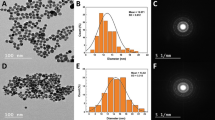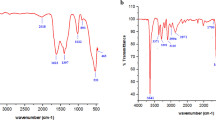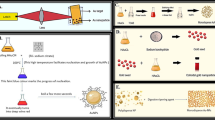Abstract
Ferrocene (Fc)-functionalized gold nanoparticles (Fc-GNPs) have been synthesized and tested for anti-tumor activity in breast cancer and normal cell lines MCF-7 and MCF-10a, respectively. Synthesized Fc-GNPs exhibited homogeneous particle distribution as evident from transmission electron microscopy (TEM). Energy dispersive X-ray spectroscopy (EDX) showed the homogenous ligation of Fc on gold nanoparticles. Atomic emission spectroscopy-inductively coupled plasma (AES-ICP) was used to quantify the amount of Fc per GNPs and found to be 84 Fc units per GNPs. Gel electrophoresis and UV–visible (UV–Vis) analysis indicated that Fc-GNPs interacted with DNA. Binding interactions of Fc-GNPs with DNA were investigated using UV–Vis spectrum. Hypochromism and shift towards shorter wavelength was observed with addition of DNA in Fc-GNPs, indicating electrostatic mode of binding of DNA with Fc-capped AuNPs. Drug release experiments performed using dialysis bag method revealed that maximum amount of Fc was released from GNPs in 10–19 h. Cancer cell line treatments showed that Fc-GNPs were comparatively more toxic to MCF-7 (breast cancer cell line) as compared to MCF-10a (breast normal cell line) at 20 μM Fc-GNPs. We did not find any significant differences in Fc and Fc-GNPs treatment in breast normal cell line MCF-10a at 10 μM or 20 μM. However, the toxic effect of the Fc increased sparingly when concentration was raised to 20 μM from 10 μM. Interestingly, Fc-GNPs have higher anti-tumor effect as compared to Fc alone in cancer cell line.
Similar content being viewed by others

Avoid common mistakes on your manuscript.
Introduction
Cancer is one of the leading causes of deaths worldwide. Due to the challenges posed by conventional therapies, scientists and physicians are enthusiastically finding more efficient ways to treat cancer. One of the major challenges in handling the disease is the emergence of severe side effects due to non-specific drug targets that has led to revolutionize the field of anti-neoplastic drugs. One of the major disadvantages of currently used anti-cancer chemotherapeutics includes non-specificity and non-bioavailability that leads to severe toxicity to normal and untargeted tissues and organs (Boulikas and Vougiouka 2003). More recent approaches to treat cancer focus on targeted therapies that involve a generation of new compounds, which are less toxic to normal cells as compared to cancer cells. Furthermore, developments have been made up to improve drug delivery systems that can reduce the non-specific effects of the drugs (Peppas and Blanchette 2012).
Organometallic compounds are reported as anti-cancer compounds that exhibit more toxicity towards various cancer cell lines (Alama et al. 2009; Vessieres et al. 2005). They have a metal core attached to organic ligands (Gasser et al. 2011). A lower toxicity to normal cells as compared to cancerous cells and their structural diversity makes them a powerful candidate to design an efficient and innovative medicinal compound (Ornelas 2011). Their structure can be functionalized with several molecules of choice in a variety of ways that further broaden up their scope (Alama et al. 2009). However, due to their high reactivity and insolubility in water, they cannot be used as a drug directly and modifications are required to further manipulate their anti-tumor behavior in aqueous media (Gasser et al. 2011).
Ferrocene is a member of organometallic family; first iron-based organometallic compounds whose anti-proliferative properties have been reported (Alama et al. 2009; Gasser et al. 2011; Morantes et al. 2012). Cytotoxicity of ferrocenium salts have been tested against breast cancer cell lines and it was found that ferrocene derivatives induce DNA damage by releasing ROS species on both hormone-dependent and independent cancer cell lines (Pizzaro et al. 2010; Tabbi et al. 2002; Vera et al. 2014).
In addition, different drug delivery strategies are being adopted to enhance chemotherapeutic effect of anti-cancerous drugs (Wang and Guo 2013). Nano drug delivery system (NDS) due to their versatile properties offer many advantages including localized drug delivery, ameliorate drug efficiency by providing increased drug dose at target site thereby providing rapid onset of therapeutic effect. In addition, they offer rapid dissolution of drug (Hughes 2005; Kaparissides et al. 2006; Wilczewska et al. 2012). Biocompatibility of gold nanoparticles (NPs) make them ideal vehicle for in vitro and in vivo drug delivery (Song et al. 2016). Thus, drugs conjugated onto NPs can reach target effectively, and are expected to exhibit enhanced antitherapeutic effect as the threshold of therapeutic window of a drug reduce sparingly (Soppimath et al. 2011).
Shah et al. (2008) studied that ferrocene intercalation with double-stranded (ds) DNA via UV–Vis spectroscopy. Furthermore, Pellegrino et al. (2007) studied the interactions of nanoparticles and DNA using gel electrophoresis. In the reported work, we addressed the aqueous solubility of ferrocene by conjugating it onto the gold nanoparticles in aqueous media by adopting Sabahat et al. (2018) method. Binding properties of Fc-GNPs with ds DNA was investigated using UV–visible spectroscopy. We have also optimized and investigated the activity of Fc alone as well as Fc-functionalized gold nanoparticles in breast normal cell line (MCF-10a) and breast cancerous cell line (MCF-7).
Materials and methods
Chemicals
Tetrachloroaurate trihydrate, HAuCl4.3H2O (Sigma-Aldrich), tri-sodium citrate 2-hydrate (Panreac), sodium chloride (Merck), bis(p-sulfonatophenyl)phenylphosphine dihydrate dipotassium salt (Sigma-Aldrich), mercaptoalkyoligoethylene glycol (PEG-OH) and thiolated ferrocene substrate (Fc) (Prochimia), K2SO4 (Sigma-Aldrich). The solvents used were ethanol, methanol (Sigma-Aldrich), distilled water. Aqua regia [nitric acid (HNO3), hydrochloric acid (HCl)] used for cleaning of glass wares. Dialysis bag of Avg. flat width 35 mm (1.4 in.), MWCO 12,000 Da Sigma (D6066-25EA) was used. UV analysis was performed in Perkin Elmer Spectrophotometer.
Synthesis of GNPs
Frens–Turkevich method (1973, 1951) was used to synthesize the citrate-stabilized gold nanoparticles (Cit-GNPs). To avoid aggregation, citrate was replaced by phosphine salt on gold nanoparticles by adopting Loweth et al. (1999) method. Phosphine-stabilized gold nanoparticles (Ph-GNPs) were used for functionalization of thiolated ferrocene substrate (Fc) onto gold nanoparticles in aqueous media.
Synthesis of ferrocene-capped GNPs
Sabahat et al. (2018) method was adopted for functionalization of Fc onto gold nanoparticles in aqueous media. Briefly, ethanolic solution of 10 µl Fc (10 mM) and 10 µl PEG (190 mM) was added into 2 ml of GNPs solution (100 nM) and stirred for 24 h. It was further centrifuged for 15 min. The final product was re-dissolved in distilled water to obtain the final concentration of functionalized GNPs.
Spectroscopic and biological analysis of functionalized GNPs
Spectroscopic analysis of synthesized gold nanoparticles was carried out via UV–visible spectroscopy (UV–Vis). Interaction of Fc-functionalized GNPs with ds DNA was studied through gel electrophoresis and UV–Vis spectroscopy. DNA was extracted from human blood by using standard phenol chloroform extraction protocol (Kochl et al. 2005). Extracted DNA was monitored via UV absorbance at 260 and 280 nm (A260/A280), and found sufficiently protein free.
Drug release experiments were performed using dialysis bag experiments (Zheng et al. 2014). Cell culture experiments were performed on MCF-10a (human breast normal cell line) and MCF-7 (human breast cancer cell line).
Fc-GNPs–DNA interactional study by UV–Vis spectroscopy
Interaction of DNA with Fc-GNPs was further confirmed through monitoring their absorbance shift in UV–Vis spectroscopy.
A volume of 10 µl DNA was added in Fc-GNPs solution with intervals (till no change in UV behavior was noticed) and the respective readings were scanned against 400–800 nm wavelengths.
Drug release experimental protocol
Drug release studies were performed via dialysis bag experiment at pH 7.0 in phosphate buffer saline (PBS) solution (Soppimath et al. 2011). Briefly, the 2 ml of release media of PBS (pH 7.0) was prepared. 100 µl of Fc-GNPs solution was added inside dialysis sack. After selected time intervals, 10 µl of solution was removed from release media and was replaced with fresh buffer. Release solution was collected in aliquots and analyzed by UV–Vis spectroscopy (Arias et al. 2012). A timed experiment was performed in which release was monitored up to 48 h.
Sample preparation for gel electrophoresis
DNA interaction with Fc-GNPs was studied by incubating DNA solution with Fc-GNPs for 2, 4, 24 and 48 h. A volume of 4 µl of solution was taken out and subjected to gel electrophoresis. Interaction of Fc-GNPs with DNA was studied by visualizing changes in fluorescence of ethidium bromide dye when visualized under UV illuminator.
Cell culture experiments
The commercial human cell lines MCF-10a (human normal breast cell line) and MCF-7 (human breast cancer cells) were used for cell culture experiments. Both cell lines were maintained in complete DMEM containing 10% FBS, l-glutamine, and 100 U/ml penicillin–streptomycin. The media were pre-warmed before use by placing into a water bath set at 37 °C ± 1 °C for 15–30 min. Cell culture was observed daily under an inverted microscope to ensure culture is free of contamination and culture has not reached confluence.
Cell line treatments protocol
MCF-7 or MCF-10a cells (104 cells/well) were plated into 6-well culture plates in triplicate. After incubation for 2–3 days at 37 °C ± 1 °C in 5% CO2 incubator, the cells were washed with phosphate buffer and new medium was added to cells. Cells were treated with GNP, Fc-GNP, and Fc in triplicates. Ferrocene is practically insoluble in aqueous media and was dissolved in DMSO. Cells were continuously monitored for viability until 48 h and images were captured. Cell viability was determined using trypan blue dye exclusion for viable and total cell counting using a hemocytometer.
Results and discussion
TEM evaluation
TEM images of gold nanoparticles and ferrocene-functionalized gold nanoparticles are shown (Fig. 1a, b). Homogenous distribution of nanoparticles was observed in every TEM image. Nanoparticles were evenly distributed in solution form and had different phases, which provided enhanced surface area for reactivity. Size of the nanoparticles ranged from 15 to 20 nm.
Energy dispersive X-ray (EDX) interpretation
EDX analysis of Fc-GNPs exposed all the elements that were present in synthesized nanoparticle solutions (Fig. 1c). Spectrum analysis of Fc-GNPs identified the presence of iron element in solution that confirmed the ligation of ferrocene over gold nanoparticles. In depth, analysis showed homogenous distribution of ferrocene over each gold nanoparticle present in the solution (Fig. 1d).
Atomic emission spectroscopy-inductively coupled plasma
The quantification of Fc per GNP was carried out via atomic emission spectroscopy-inductively coupled plasma (AES-ICP). The calculated amount of Fc per GNP was found to be 84 units of Fc per GNP.
UV–visible analysis
UV–Vis spectrum of Fc-GNPs with DNA showed shift as well as decrease in absorbance (Fig. 2). Hypochromism along with shift towards shorter wavelength (blue shift) inferred the utilization of all the available sites on Fc-GNPs. In Fig. 2, it can also be noticed that at ~ 700 nm, UV responses intercept which may indicates the Fc-GNPs and DNA complexation. Ferrocene undergoes structural conformational changes, it can possibly be proposed that Fc-GNPs possess electrostatic mixed mode of binding with DNA. Ferrocene corresponds to ferrocenium ion that leads to a series of redox reactions that disrupt DNA structure.
Drug release investigation
UV analysis of Fc release experiment is shown (Fig. 2b). Maximum release of Fc from GNPs was detected between 10 and 19 h.
Gel electrophoresis
Fc-GNPs showed competitive binding (in the presence of ethidium bromide, EtBr) with DNA as compared to DNA–dye alone. A slight increase in luminescence as compared to control (DNA) was observed, we can propose that Fc-GNPs may interact with EtBr also (Fig. 2c).
Morphological evaluation of cell lines through microscopy
In vitro investigation of Fc-GNPs was carried out on normal MCF-10a and tumorigenic MCF-7 breast cancer cell lines. Both cell lines were cultured for 24 h and were treated with 10 μM and 20 μM of Fc and Fc-GNPs for 48 h. Fc induced more cell death in MCF-7 cell line at 20 μM as compared to MCF-10a cell line. However, no significant differences were seen at 10 μM (Fig. 3a). Selective toxicity of different Fc derivatives has been reported in different cell lines (Vera et al. 2014; Duivenvoorden et al. 2005; Fouda et al. 2007). We did not find any significant differences in cell viability in MCF-10a cell line when treated with Fc or Fc-GNPs at 10 μM or 20 μM (Fig. 3b). GNPs alone did not show any significant cytotoxic effect on both cell lines. Gold nanoparticles were observed to integrate into cells genome very effectively without disturbing cells structure or causing cell death proving themselves to be an efficient carrier for drug (Chithrani et al. 2006). However, the treatment with Fc-GNPs significantly (p value < 0.01) induced more cell death in MFC-7 cell line at 20 μM as compared to MCF-10a cell line. Cytotoxicity was observed with very less amount of Fc ligated onto the GNPs. Graphical representation of cell lines studies is displayed in Fig. 3a, b.
Conclusion
Gold nanoparticles not only addressed the issue of Fc aqueous insolubility, but were also capable of delivering even low amount of Fc to cells where Fc showed its anti-cancer activity. Cytotoxicity was observed with Fc-ligated GNPs in breast cancer cell line. Electrostatic mode of Fc-GNPs binding with DNA was monitored via UV analysis. Gel electrophoresis analysis also confirms the Fc-GNPs interaction with DNA. A time span of 10–19 h was required for Fc release from GNPs as evident from drug release experiment performed by dialysis bag. Keeping all results, Fc-GNPs can be used as anti-cancer agent for future studies.
References
Alama A, Tasso B, Novelli F, Sparatore F (2009) Organometallic compounds in oncology: implications of novel oranotins as antitumor agents. Drug Discov Today 14:9–10. https://doi.org/10.1016/j.drudis.2009.02.002
Arias JL, Gallardo V, Ruiz MA (2012) Multifunctional anticancer nanomedicine based on a magnetically responsive cyanoacrylate polymer. Nanomedicine—cancer, diabetes, and cardiovascular, central nervous system, pulmonary and inflammatory diseases. Methods Enzymol 508:61–88. https://doi.org/10.1016/b978-0-12-391860-4-00004-5
Boulikas T, Vougiouka M (2003) Cisplatin and platinum drugs at the molecular level. Oncol Rep 10(6):1663–1682. https://doi.org/10.3892/or.10.6.1663
Chithrani DB, Ghazani AA, Chan WCW (2006) Determining the size and shape dependence of gold nanoparticles uptake into mammalian cells. Nano Lett 6(4):662–668. https://doi.org/10.1021/nl052396o
Duivenvoorden CMW, Liu Y, Schatte G, Kraatz BH (2005) Synthesis of redox free ferrocene pyrazole conjugates and their cytotoxicity in human mammary adenocarcinoma MCF-7 cells. Inorg Chim Acta 358:3183–3189. https://doi.org/10.1016/j.ica.2005.04.010
Fouda RFM, Abd-Elzaher MM, Abdelsamaia AR, Labib AA (2007) On the medicinal chemistry of ferrocene. Appl Organomet Chem 21:613–625. https://doi.org/10.1002/aoc.1202
Frens G (1973) Controlled nucleation for the regulation of the particle size in monodisperse gold suspensions. Nat Phys Sci 241:20–22. https://doi.org/10.1038/physci241020a0
Gasser G, Ott I, Nolte MN (2011) Organometallic anticancer compounds. J Med Chem Perspect 54:3–25. https://doi.org/10.1021/jm100020w
Hughes AG (2005) Nanostructure-mediated drug delivery. Nanomedicine 1(1):22–30. https://doi.org/10.1016/j.nano.2004.11.009
Kaparissides C, Alexandridou S, Kotti K, Chaitidou S (2006) Recent advances in novel drug delivery systems. J Med. https://doi.org/10.2240/azojono0111
Kochl S, Niederstatter H, Parson W (2005) DNA extraction and quantification of forensic samples using the phenol chloroform method and real time PCR. Methods Mol Biol 297:13–29. https://doi.org/10.1385/1-59259-867-6:013
Loweth JC, Caldwell BW, Peng X, Alivisatos PA, Schultz GP (1999) DNA-based assembly of gold nanocrystals. Angew Chem Int Ed 5:1808–1812. https://doi.org/10.1002/(SICI)1521-3773(19990614)38:12%3c1808:AID-ANIE1808%3e3.0.CO;2-C
Morantes AYC, Melendez E, Singh PS, Vick REJ (2012) Cytotoxicity and reactive oxygen species generated by ferrocenium and ferrocene on MCF-7 and MCF10A cell lines. Cancer Sci Therapy. https://doi.org/10.4172/1948-5956.1000154
Ornelas C (2011) Application of Ferrocene and its derivatives in cancer research. New J Chem 35:1973–1985. https://doi.org/10.1039/c1nj20172g
Pellegrino T, Sperling AR, Alivisatos PA, Parak JW (2007) Gel electrophoresis of gold-DNA nanoconjugates. J Biomed Biotechnol 9:1–9. https://doi.org/10.1155/2007/26796
Peppas LB, Blanchette JO (2012) Nanoparticles and targeted systems for cancer therapy. Adv Drug Deliv Rev 64:206–212. https://doi.org/10.1016/j.addr.2012.09.033
Pizzaro AM, Habetemariam A, Sadler PJ (2010) Activation mechanisms for organometallic anticancer compounds. Top Organomet Chem 32:21–56. https://doi.org/10.1007/978-3-642-13185-1_2
Sabahat S, Janjua NK, Akhter Z, Hassan MU (2018) Ferrocene-functionalized gold nanoparticles: study of a simple synthesis method and their electrochemical behavior. Chem Pap 73(4):943–951. https://doi.org/10.1007/s11696-018-0646-9
Shah A, Qureshi R, Janjua KN, Haque S, Ahmed S (2008) Electrochemical and spectroscopic investigations of protonated ferrocene-DNA intercalation. Anal Sci 24(11):1437–1441. https://doi.org/10.2116/analsci.24.1437
Song S, Hao Y, Yang X, Patra P, Chen J (2016) Using gold nanoparticles as delivery vehicles for targeted delivery of chemotherapy drug fludarabine phosphate to treat hematological cancers. J Nanosci Nanotechnol 16(3):2582–2586
Soppimath KS, Aminabhavi MT, Kulkarni RA, Rudzinski EW (2011) Biodegradable polymeric nanoparticles as drug delivery devices. J Controll Releases 70(1–2):1–20. https://doi.org/10.1016/S0168-3659(00)00339-4
Tabbi G, Cassino C, Cavigiolio G, Colangelo D, Ghiglia A, Viano I, Osella D (2002) Water stability and cytotoxic activity relationship of a series of ferrocenium derivatives. ESR insights on the radical production during the degradation process. J Med Chem 45:5786–5796. https://doi.org/10.1021/jm021003k
Turkevich J, Stevenson PC, Hiller J (1951) A study of the nucleation and growth processes in the synthesis of colloidal gold. Discuss Faraday Soc 11:55–75. https://doi.org/10.1039/DF9511100055
Vera LJ, Rullan J, Santos N, Jimenez J, Rivera J, Santana A, Briggs J, Rheingold LA, Matta J, Melendez E (2014) Functionalized ferrocenes: the role of the para substituent on the phenoxy pendant group. J Organomet Chem 749:204–214. https://doi.org/10.1016/j.jorganchem.2013.10.002
Vessieres A, Top S, Pigeon P, Hillard E, Boubeker L, Spera D, Jaouen G (2005) Modifications of the estrogenic properties of diphenols by the incorporation of ferrocene. Generation of antiproliferative effects in vitro. Med Chem 48(12):3937–3940. https://doi.org/10.1021/jm050251o
Wang X, Guo Z (2013) Targeting and delivery of platinum-based anticancer drugs. Chem Soc Rev 42:202–224. https://doi.org/10.1039/C2CS35259A
Wilczewska AZ, Niemirowicz K, Markiewicz KH, Car H (2012) Nanoparticles as drug delivery systems. Pharmacol Rep 64(5):1020–1037. https://doi.org/10.1016/S1734-1140(12)70901-5
Zheng H, Li S, Pu Y, Lai Y, He B, Gu Z (2014) Nanoparticles generated by PEG-Chrysin conjugates for efficient anticancer drug delivery. Eur J Pharm Biopharm 87(3):454–460. https://doi.org/10.1016/j.ejpb.2014.03.011
Acknowledgements
The author is highly thankful to Physics department, COMSATS University, Islamabad, Pakistan. Special thanks to Georgetown University Reservoir Road, NW Washington, DC 20057 for morphological analysis.
Funding
This study was funded by COMSATS Institute of Information Technology (PK) [(16-49/CRGP/CIIT/IBD/13/227)].
Author information
Authors and Affiliations
Corresponding author
Ethics declarations
Conflict of interest
There is no conflict of interest.
Additional information
Publisher's Note
Springer Nature remains neutral with regard to jurisdictional claims in published maps and institutional affiliations.
Rights and permissions
About this article
Cite this article
Amjad, S., Naeem, A. & Sabahat, S. In vitro investigation of anti-cancer activity of ferrocene-functionalized gold nanoparticles. Chem. Pap. 74, 125–131 (2020). https://doi.org/10.1007/s11696-019-00864-0
Received:
Accepted:
Published:
Issue Date:
DOI: https://doi.org/10.1007/s11696-019-00864-0






